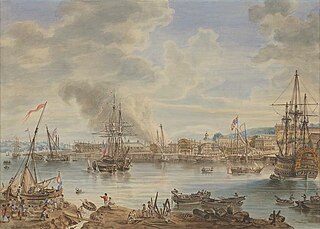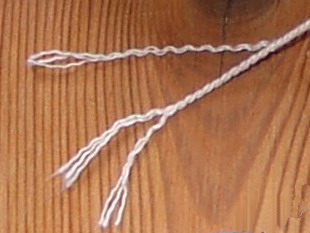Spinning is a twisting technique to form yarn from fibers. The fiber intended is drawn out, twisted, and wound onto a bobbin. A few popular fibers that are spun into yarn other than cotton, which is the most popular, are viscose, animal fibers such as wool, and synthetic polyester. Originally done by hand using a spindle whorl, starting in the 500s AD the spinning wheel became the predominant spinning tool across Asia and Europe. The spinning jenny and spinning mule, invented in the late 1700s, made mechanical spinning far more efficient than spinning by hand, and especially made cotton manufacturing one of the most important industries of the Industrial Revolution.

Yarn is a long continuous length of interlocked fibres, used in sewing, crocheting, knitting, weaving, embroidery, ropemaking, and the production of textiles. Thread is a type of yarn intended for sewing by hand or machine. Modern manufactured sewing threads may be finished with wax or other lubricants to withstand the stresses involved in sewing. Embroidery threads are yarns specifically designed for needlework. Yarn can be made of a number of natural or synthetic materials, and comes in a variety of colors and thicknesses. Although yarn may be dyed different colours, most yarns are solid coloured with a uniform hue.
A whipping knot or whipping is a binding of marline twine or whipcord around the end of a rope to prevent its natural tendency to fray.

Worsted is a high-quality type of wool yarn, the fabric made from this yarn, and a yarn weight category. The name derives from Worstead, a village in the English county of Norfolk. That village, together with North Walsham and Aylsham, formed a manufacturing centre for yarn and cloth in the 12th century, when pasture enclosure and liming rendered the East Anglian soil too rich for the older agrarian sheep breeds. In the same period, many weavers from the County of Flanders moved to Norfolk. "Worsted" yarns/fabrics are distinct from woollens : the former is considered stronger, finer, smoother, and harder than the latter.

A cable length or length of cable is a nautical unit of measure equal to one tenth of a nautical mile or approximately 100 fathoms. Owing to anachronisms and varying techniques of measurement, a cable length can be anywhere from 169 to 220 metres, depending on the standard used.

A rope is a group of yarns, plies, fibres, or strands that are twisted or braided together into a larger and stronger form. Ropes have tensile strength and so can be used for dragging and lifting. Rope is thicker and stronger than similarly constructed cord, string, and twine.

Chatham Dockyard was a Royal Navy Dockyard located on the River Medway in Kent. Established in Chatham in the mid-16th century, the dockyard subsequently expanded into neighbouring Gillingham; at its most extensive two-thirds of the dockyard lay in Gillingham, one-third in Chatham.

A Matthew Walker knot is a decorative knot that is used to keep the end of a rope from fraying. It is tied by unraveling the strands of a twisted rope, knotting the strands together, then laying up the strands together again. It may also be tied using several separate cords, in which case it keeps the cords together in a bundle. The traditional use of the knot is to form a knob or "stopper" to prevent the end of the rope from passing through a hole, for instance in rigging the lanyards which tension the shrouds on older sailing ships with standing rigging of fibre cordage.
In the textile arts, plying is a process of twisting one or more strings of yarn together to create a stronger yarn. Strands are twisted together in the direction opposite that in which they were spun. Plied yarns will not unravel, break, or degrade as easily as unplied yarns. When enough twist is added to the plies to counter the initial twist of each strand, the resulting yarn is "balanced", having no tendency to twist upon itself.

Twine is a strong thread, light string or cord composed of string in which two or more thinner strands are twisted, and then twisted together (plied). The strands are plied in the opposite direction to that of their twist, which adds torsional strength to the cord and keeps it from unravelling. This process is sometimes called reverse wrap. The same technique used for making twine is also used to make thread, which is thinner, yarn, and rope, which is stronger and thicker, generally with three or more strands.

Wire rope is composed of as few as two solid, metal wires twisted into a helix that forms a composite rope, in a pattern known as laid rope. Larger diameter wire rope consists of multiple strands of such laid rope in a pattern known as cable laid. Manufactured using an industrial machine known as a strander, the wires are fed through a series of barrels and spun into their final composite orientation.

To worm, parcel and serve a line is to apply a multi-layered protection against chafe and deterioration to standing rigging. It is a technique not usually used on modern small boats, but is found extensively on traditionally-rigged sailing ships. Worming, parcelling and serving —referred to collectively as "service"— is traditionally applied only to traditional twisted rope, either natural fiber or steel wire-rope, not the braided line almost exclusively used on modern vessels, but some traditional vessels now use modern high modulus braided lines in place of wire rope and serve the line to maintain the traditional appearance. It can be applied to the entire length of a line, such as a shroud, or selectively, to specific parts of a line, such as over the spliced ends of a stay, where the chafe on the middle section of the stay precludes complete protection.

Spinning is an ancient textile art in which plant, animal or synthetic fibres are drawn out and twisted together to form yarn. For thousands of years, fibre was spun by hand using simple tools, the spindle and distaff. After the introduction of the spinning wheel in the 13th century, the output of individual spinners increased dramatically. Mass production later arose in the 18th century with the beginnings of the Industrial Revolution. Hand-spinning remains a popular handicraft.

Naval Dockyard, Mumbai, abbreviated as ND (Mbi) and previously known as the Bombay Dockyard, is an Indian shipbuilding yard in Mumbai.
Textile manufacturing is one of the oldest human activities. The oldest known textiles date back to about 5000 B.C. In order to make textiles, the first requirement is a source of fibre from which a yarn can be made, primarily by spinning. The yarn is processed by knitting or weaving to create cloth. The machine used for weaving is the loom. Cloth is finished by what are described as wet process to become fabric. The fabric may be dyed, printed or decorated by embroidering with coloured yarns.

The Ropewalk is a building on the island of Lindholmen in southeastern Sweden. It is located within the naval base in Karlskrona. Dating from 1692, the rope factory terminated production in 1960 but in 2006, after renovation, it was opened to the public with exhibitions and demonstrations of ropemaking. With a length of some 300 metres (980 ft), the Ropewalk is Sweden's longest wooden building.
Doubling is a textile industry term synonymous with combining. It can be used for various processes during spinning. During the carding stage, several sources of roving are doubled together and drawn, to remove variations in thickness. After spinning, yarn is doubled for many reasons. Yarn may be doubled to produce warp for weaving, to make cotton for lace, crochet and knitting. It is used for embroidery threads and sewing threads, for example: sewing thread is usually 6-cable thread. Two threads of spun 60s cotton are twisted together, and three of these double threads are twisted into a cable, of what is now 5s yarn. This is mercerised, gassed and wound onto a bobbin.

String is a long flexible structure made from fibers twisted together into a single strand, or from multiple such strands which are in turn twisted together. String is used to tie, bind, or hang other objects. It is also used as a material to make things, such as textiles, and in arts and crafts. String is a simple tool, and its use by humans is known to have been developed tens of thousands of years ago. In Mesoamerica, for example, string was invented some 20,000 to 30,000 years ago, and was made by twisting plant fibers together. String may also be a component in other tools, and in devices as diverse as weapons, musical instruments, and toys.
The Corderie Royale International de la mer is a vast museum complex located in the heart of the maritime Arsenal de Rochefort. The building built in 1666 has been classified as a historic monument since 1967, and currently a candidate for inscription on the UNESCO World Heritage List.

Downs & Son was a rope and twine manufacturing firm located in Brunswick, Victoria, Australia, which operated the Samson Cordage Works factory in Brunswick. The factory was the oldest and last surviving rope works in the northern suburbs of Melbourne, and the best surviving in Melbourne.

















